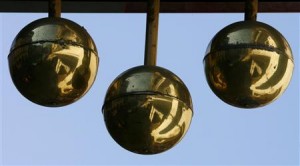Many traditional shops have iconic symbols outside their doors. The use of symbols for traditional shops dates back to a time in Europe when most people were unable to read or write. Instead, the common folk would rely on iconic symbols to identify the shops in medieval villages. Over time, the use of these symbols carried over and many are still in use today.

The traditional sign of a pawn shop
The traditional symbol for pawn shops is three gold balls suspended from a bar. While this has come to be a well-known symbol for pawn shops, the origins of the symbol aren’t so clear. There is a variety of lore associated with the origins and meaning of the symbol.
One of the most common stories about the origins of the pawnbrokers’ symbol traces back to the Medici family of Florence, Italy. The symbolic meaning is said to be drawn from Lombard, which comes from the Italian province, Lombardy. Pawn shop banking is said to have started under the name Lombard banking in this province.
Lombard Merchants?
The medieval Lombard merchants used the three golden spheres as a symbol. They are said to have hung the spheres in front of their houses. In Europe, a pawn shop was called the Lombard. In London, England, a banking family was called The House of Lombard.
The golden spheres are though to have represented byzants, which were gold coins at the time. The representation of the gold coins was laid upon a sable field in a heraldic manner. Later, the coins were changed to spheres to help attract more attention from passersby.
The Medici Connection
While the Medici family may not have been the original users of the symbol, there is a legend about how the three ball symbol made its way onto their coat of arms. The legend claims that a Medici hired Charlemagne to slay a giant using three bags of rocks. From that day forward, the Medici crest used the three balls. Other families adopted the use of the three balls because of the financial success of the Medici family. The gold balls were used throughout the Middle Ages on crests as a symbol of success.
Another common story about the origins of the three gold balls is about Saint Nicholas. Saint Nicholas is the patron saint of pawnbrokers. Many believe the three gold balls symbolize the story of Saint Nicholas giving a bag of gold to each of a poor man’s three daughters to allow them the financial means to get married.
In any case, the mystery and magic captured in these stories provides a rich history behind the three gold balls found outside of pawn shops. The next time you visit your local pawn shop, you might want to inquire about the owner’s personal interpretation of the meaning behind the three gold balls. The beauty of the symbol is that everyone can find their own meaning in those three gold balls.


